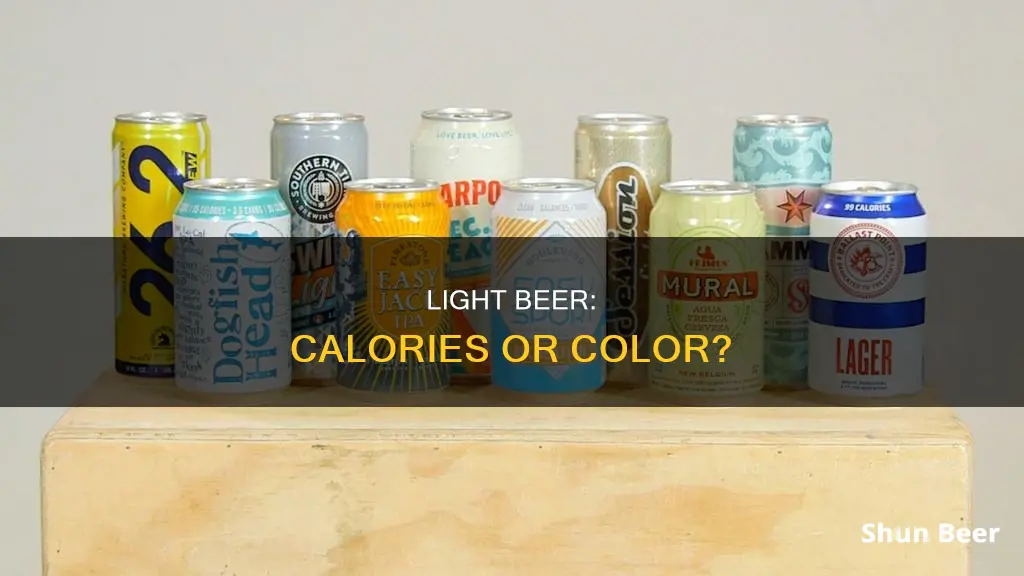
Light beer is a popular choice for those looking for a lighter drinking option. But what does light actually mean? The term can refer to a beer's colour, calorie content, alcohol content, or flavour. In the US, the Alcohol and Tobacco Tax and Trade Bureau (TTB) mandates that light beers have significantly fewer calories than their full-strength counterparts. This is achieved by lowering the number of carbohydrates and reducing alcohol content. However, the definition of light beer varies among brands, and it's important to note that drinking the same amount of light beer as regular beer may not lead to reduced weight gain as intended.
| Characteristics | Values |
|---|---|
| Calories | Fewer calories than regular beer |
| Alcohol Content | Lower alcohol content than regular beer |
| Carbohydrates | Lower carbohydrate content than regular beer |
| Taste | Often perceived as having a worse taste than regular beer |
| Price | Usually more expensive than regular beer |
What You'll Learn

Light beer is the best-selling beer style in the US
Light beer is the bestselling beer style in the US. In 2020, light beer was the most popular type of brew in the country, with nearly 40% of beer consumption falling into this category. In 2022, Bud Light was the best-selling beer, with a 12.6% market share. However, in 2023, Modelo Especial took over as the top-selling beer brand in the US, with an 8.7% share of overall beer sales in retail stores.
The success of light beer in the US can be attributed to various factors. One reason is that light beer is typically lower in calories and alcohol content, making it a popular choice for health-conscious consumers or those looking to reduce their alcohol intake. Additionally, the major breweries that produce light beers have invested significantly in marketing and distribution, ensuring their products are widely available and recognisable to consumers.
The production of light beer also has some unique characteristics. While it is brewed in a similar manner to regular beer, creating a light beer with fewer calories can be more involved and technically challenging. This may be why light beers are often produced by larger breweries with the necessary resources and expertise.
Despite its popularity, light beer is sometimes viewed as a lesser beer style. This perception may be due to the notion that light beers compromise flavour to achieve lower calorie content. However, some brewers have challenged this perception by creating light beers with more flavour, such as Sam Adams Light, which was introduced in 2001 as a lighter version of Samuel Adams Boston Lager.
While light beer is the bestselling style in the US, the market is dynamic and consumer preferences can change. For example, the sales of Bud Light and Budweiser dropped significantly in 2023 following a conservative backlash over a social media campaign. This boycott benefited the import beer industry, with Modelo Especial taking the top spot as the best-selling beer brand.
Calories in Busch Lite Beer: Nutritional Facts
You may want to see also

Light beers are lower in calories
Light beers are indeed lower in calories. The number of calories in a beer is directly correlated with its alcohol content, and light beers are typically lower in alcohol.
The process of making light beer involves lowering the number of carbohydrates that come from malt and grains. Enzymes are destroyed during the brewing process to reduce the amount of fermentable sugars, which in turn lowers the ABV and calorie count.
The Alcohol and Tobacco Tax and Trade Bureau (TTB) mandates that light beers must reflect "a meaningful decrease in calories compared with a reference full-strength version". The TTB also requires brewers to state the calorie, fat, and carb counts on the packaging.
For example, a 12-ounce serving of regular beer contains on average 153 calories, while a light beer typically has around 103 calories. Bud Light, one of the most common light beers, has 110 calories, while a Guinness, a dark beer, has 125 calories.
However, it is important to note that the term "light" is relative and can vary among brands. Additionally, drinkers of light beer may consume more beers overall than those who drink standard varieties, as it may take twice the amount of light beer to reach the same level of intoxication.
Calorie Count for O'Doul's Amber Beer Revealed
You may want to see also

Light beers are typically lower in alcohol content
The alcohol content of light beers is regulated by the Alcohol and Tobacco Tax and Trade Bureau (TTB), which requires that light beers have "a meaningful decrease in calories compared with a reference full-strength version." Additionally, the TTB mandates that brewers disclose details such as calories, fat, and carbs on the packaging.
While light beers are generally lower in alcohol and calories, it's important to note that the specific definition of "light beer" can vary among brands. For example, a "light beer" could refer to a beer with fewer calories, less alcohol, or both. As a result, it's always a good idea to read the labels and make informed choices based on your specific needs and preferences.
The perception of light beers is evolving, and they continue to be extremely popular, constituting almost half of beer consumption in the United States. However, it's worth noting that the health benefits of light beers are still debated, and some studies suggest that moderate consumption of regular beer may offer more health benefits than light beers.
Calories and Carbs in Budweiser Beer: What's the Count?
You may want to see also

Dark beers can be just as light as light beers
It's a common misconception that dark beers are heavier than light beers. However, this isn't always the case. Dark beers can be just as light as light beers in terms of alcohol content, calories, and density. The key factor in determining the "lightness" of a beer is its alcohol by volume (ABV) rather than its colour.
Dark beers are made from heavily roasted grains, which give them their darker colour. The roasting process also adds chocolate and coffee flavours to the beer. However, it does not add more alcohol, which is directly correlated with calorie content. In other words, the higher the ABV, the higher the calorie count.
For example, a serving of Guinness, a dark beer, has 125 calories, while a Bud Light, one of the most common light beers, has 110 calories. Similarly, a Samuel Adams Black Lager, a light-bodied dark beer, has a mere 4.9% ABV and likely under 200 calories in a 12-ounce serving. In contrast, a highly carbonated, pale-coloured Golden Monkey beer has a whopping 9.5% ABV and likely over 300 calories in a 12-ounce serving.
When it comes to food pairings, light beers typically go well with lighter dishes such as pasta, salads, pizza, and chicken. On the other hand, dark beers complement grilled meats, roasted meats, smoked meats, seafood, and spicy dishes.
While dark beers are often associated with rich, heavy flavours, it's important to remember that their colour does not always indicate their weight or calorie content. So, the next time you're looking for a light beer, don't be afraid to explore the darker options!
Calorie Counting: Beer-Battered Shrimp's Caloric Value
You may want to see also

Light beers are often seen as lesser beers
The perception of light beers as inferior has been a longstanding one, dating back to their introduction in the early 1970s. Historically, light beers have been viewed as "watered-down versions" of their original, more robust counterparts, with flavour being sacrificed for lower calories. This perception was so strong that when a craft brewer like Samuel Adams introduced a light version of its signature beer, it was seen as an unusual move, almost unbefitting of a craft brewer.
The process of creating a light beer involves technical mastery and a deep understanding of the brewing process. To reduce calories, brewers employ techniques such as decoction mashing, which prevents the addition of water or heat during multi-step mashes, and kilning malt at higher temperatures to kill enzymes and reduce fermentable sugars. While these techniques do not inherently make the brewing process more difficult, they require time, attention to detail, and a high level of scrutiny over ingredients.
The negative perception of light beers may also be influenced by their mass-market appeal. Light beers are the bestselling beer style in the country, with mega-brewers like Anheuser-Busch dominating the market. Craft brewers, who focus on flavour and the art of brewing, may view light beers as a compromise in flavour to cater to a broader audience. Additionally, the very term "light" may contribute to the perception of these beers as inferior, implying a lack of substance or depth.
However, it's important to note that light beers cater to a specific consumer demand, offering a lower-calorie and lower-alcohol option without compromising the beer experience entirely. While they may not possess the same flavour complexity as full-strength beers, they have their place in the market and continue to be a popular choice among American beer drinkers.
Calories in Blue Moon's Pumpkin Beer: A Healthy Treat?
You may want to see also
Frequently asked questions
Light beer is a beer that is low in calories and, as a result, usually has a lower alcohol content.
Brewers destroy enzymes during the brewing process to lower the amount of fermentable sugars, which in turn lowers the ABV and calories.
Light beers are not necessarily healthier. While they have fewer calories, drinkers of light beer tend to consume more beers overall than those who drink standard varieties.
Not necessarily. Dark beers can be just as light in alcohol, calories, and density as light beers. The darkness of the beer comes from heavily roasted grains, which do not add more alcohol or calories.







